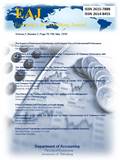THE EFFECT OF EARNINGS PERSISTENCE AND EARNINGS TRANSPARENCY ON COMPANY PERFORMANCE WITH CORPORATE GOVERNANCE AS MODERATING VARIABLE (Empirical Study in Manufacturing Company that Listed in Indonesia Stock Exchange in 2014-2016)
DOI:
https://doi.org/10.32493/eaj.v2i2.y2019.p86-94Keywords:
AccountingAbstract
ABSTRACT
Earnings persistence and earnings transparency are an important factors in company performance. The quality of financial statement will differentiate performance between one company to another. The research purposed to analyze the effect of earnings persistence and earnings transparency on the company performance. In addition, the research purposed to analyze corporate governance as a moderating variable can strengthens the effect between earnings persistence and earnings transparency on company performance. This research using sample of 363 firms-year in 2014-2016 and applying panel data analysis. The results show that earnings persistence variable has a positive significant effect on the company performance. Earning transparency also has a positive significant effect on company performance. For corporate governance as a moderation variable strengthens the effect between earnings persistence and earning transparency to the company performance. Size and age also have a positive significant effect on company performance.
Keywords: earnings persistence; earnings transparency; company performance; corporate governance.
References
Andriyanto, R., Effriyanti, E., & Hidayat, A. (2018). The Effect of Spiritual Intelligence (SQ) and Personality Types on Auditor’s Ability to Detect Fraud. JABI (Jurnal Akuntansi Berkelanjutan Indonesia), 1(3), 258-268.
Barth, M., Y. Konchitchki, and W. Landsman. (2013). Cost of Capital and Earnings Transparency. Journal of Accounting and Economics, Vol.55, pp.206-224.
Barth, M. and K. Schipper. (2008). Financial Reporting Transparency. Journal of Accounting, Auditing & Finance, Vol. 23, No. 2, pp. 173-190.
Beaver, W.H. (2002). Perspectives on Recent Capital Market Research. The Accounting Review, Vol.77, No.2, pp.453-474.
Daske, Hail, L.Leuz, and R. Verdi. (2008). Mandatory IFRS reporting Around The World Early Evidence On The Economic Consequences. Journal of Accounting Research, Vol. 46, pp. 1085-1142.
Dechow, P.M and I.D. Dichev. (2002). The Quality of Accruals and Earnings The Role of Accrual Estimation Errors. The Accounting Review, Vol.77 (Supplement), pp.35-59.
Dechow, P.M., G. We, and C.M. Schrand. (2010). Understanding Earnings Quality: A Review of the Proxies, Their Determinants and Their Consequences. Journal of Accounting and Economics, Vol.50, pp.344-401.
Francis, J., R. LaFond, P.M. Olsson, and K. Schipper. (2004). Costs of Equity and Earnings Attributes. The Accounting Review, Vol.79, No.4, pp.967-1010.
Gunawan, Y. (2000). Analisis Pengungkapan Informasi Laporan Tahunan Pada Perusahaan yang Terdaftar di BEJ. SNA 3, pp. 79-98.
Hartono, J. (2013). Teori Portofolio dan Analisis Investasi, Edisi Kedelapan. BPFE: Yogyakarta.
Healy, P.M. (1985). The Effect of Bonus Schemes on Accounting Decisions. Journal of Accounting & Economics, pp.85-107.
Herry, S., E. Murwaningsari, and S. Mayangsari. (2016). The Effect of Earnings Aggressiveness, Income Smoothing, Earning Transparency on Cost of Equity with Earnings Informativeness As Moderating for Companies Listed on Indonesia Stock Exchange During the Period 2011-2013. GSTF Journal on Business Review Vol.4, No.4, pp.17-27.
Hezaky, R., Z. Ansari, and M. Saikhani. (2014). The Impact of Earnings Quality and Income Smoothing on the Performance of Companies Listed in Tehran Stock Exchange. International Journal of Business and Social Science, Vol.2, No.17, pp.193-197.
Hidayat, A., & Yuliah, N. (2018). The Effect of Good Corporate Governance and Tax planning on Company Value. EAJ (Economics and Accounting Journal), 1(3), 234-241.
Ikatan Akuntan Indonesia. (2017). Standar Akuntansi Keuangan Indonesia.
Jensen, M.C and W.H. Meckling. (1976). Theory of the Firm: Managerial Behaviour Agency Costs and Ownership Structure. Journal of Financial Economics, Vol.3, pp.305-360.
Kustono, A.S. (2011). The Theoretical Construction of Income Smoothing Measurement. Journal of Economics, Business and Accountancy Ventura, Vol.14, No.1, pp.59-78.
Leuz, C., D. Nanda, and P.D. Wysocki. (2003). Earnings Management and Investor Protection: An International Comparison. Journal of Financial Economics, Vol. 69, No. 3, pp. 505-527.
Li, H. (2014). Top Executives’ Ability and Earnings Quality: Evidence from the Chinese Capital Markets. International Journal of Financial Research, Vol.5, No.2, pp.79-86.
Nichols, D.C and J.M. Wahlen. (2004). How Do Earnings Numbers Relate to Stock Return? A Review of Classic Accounting Research with Updated Evidence. Accounting Horizons, Vol.18, No.4, pp.263-286.
Penman, S and X. Zhang. (2002). Accounting Conservatism, the Quality of Earnings, and Stock Returns. The Accounting Review, Vol.77, pp.237-264.
Penman,S.H. (2003). Financial Statement Analysis and Security Valuation. Second Editon: McGraw Hill.
Sloan, R.G. (1996). Do Stock Prices Fully Reflect Information in Accruals and Cash Flow about Future Earnings? The Accounting Review, Vol.71, No.3, pp.289-315.
Subiyantoro, Edi. (1997). Hubungan Antara Kelengkapan Laporan Keuangan Dengan Karakteristik Perusahaan Publik di Indonesia, SNA 1, pp. 1-29.
Suripto, B. (1999). The Firm Characteristic Effect To Extent Of Voluntary Disclosure In The Annual Report. Simposium Nasional Akuntansi 2, pp.1-17.
Tucker, J.W. and P.A. Zarowin. (2006). Does Income Smoothing Improve Earnings Informativeness? The Accounting Review, Vol.81, No.1, pp.251-270.
Wang, J.L. (2013). Accounting Conservatism and Information Asymmetry: Evidence from Taiwan. International Business Research, Vol.6, No.7, pp.32-43.
Wahyono, Hadi. (2002). Komparasi Kinerja Perusahaan Bank dan Asuransi Studi Empiris di Bursa Efek Jakarta. Jurnal Riset Ekonomi dan Manajemen, Vol. 2, No. 2.
Published
Issue
Section
License
Copyright (c) 2024 Melinda Malau

This work is licensed under a Creative Commons Attribution-NonCommercial-ShareAlike 4.0 International License.
Authors who publish with this journal agree to the following terms:
- Authors retain copyright and grant the journal right of first publication with the work simultaneously licensed under a Creative Commons Attribution License that allows others to share the work with an acknowledgement of the work's authorship and initial publication in this journal.
- Authors are able to enter into separate, additional contractual arrangements for the non-exclusive distribution of the journal's published version of the work (e.g., post it to an institutional repository or publish it in a book), with an acknowledgement of its initial publication in this journal.
- Authors are permitted and encouraged to post their work online (e.g., in institutional repositories or on their website) prior to and during the submission process, as it can lead to productive exchanges, as well as earlier and greater citation of published work (See The Effect of Open Access).

This work is licensed under a Creative Commons Attribution-ShareAlike 4.0 International License.


